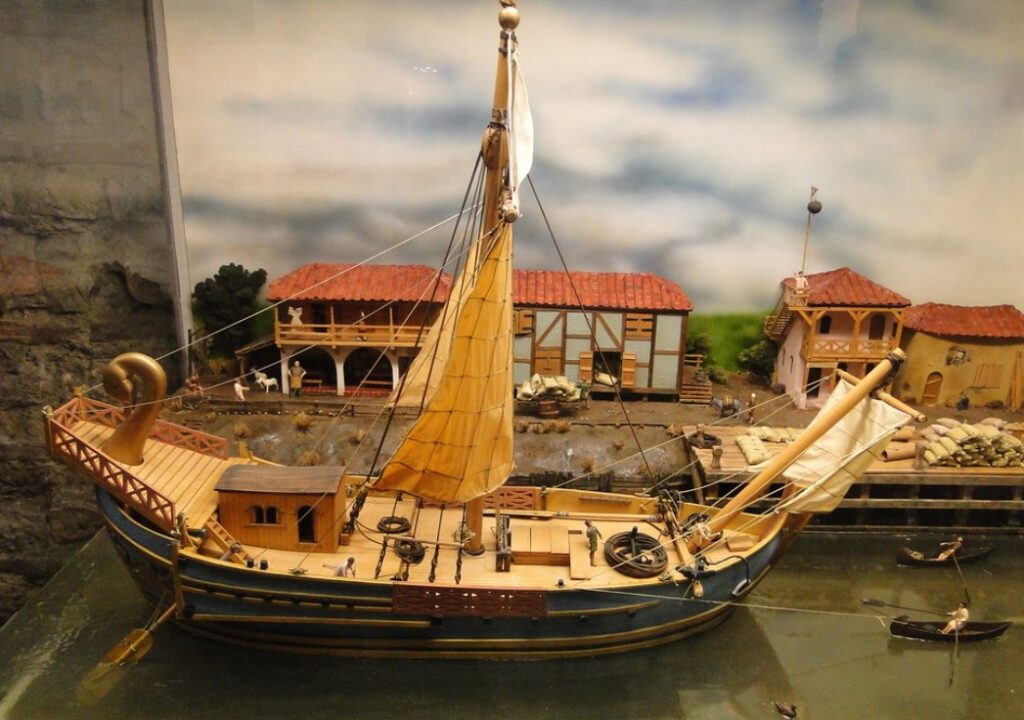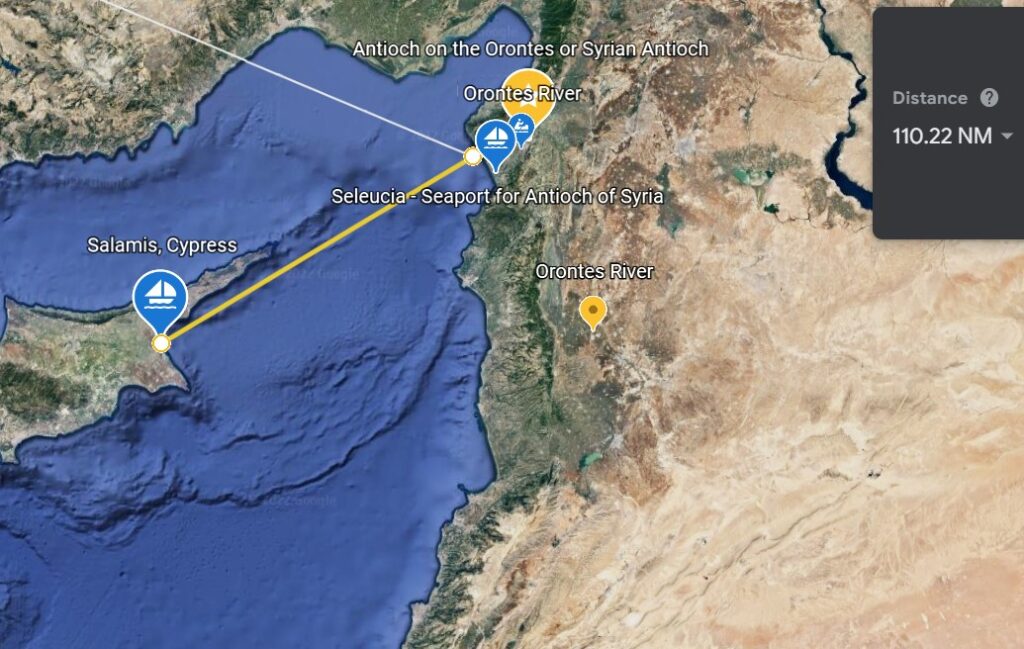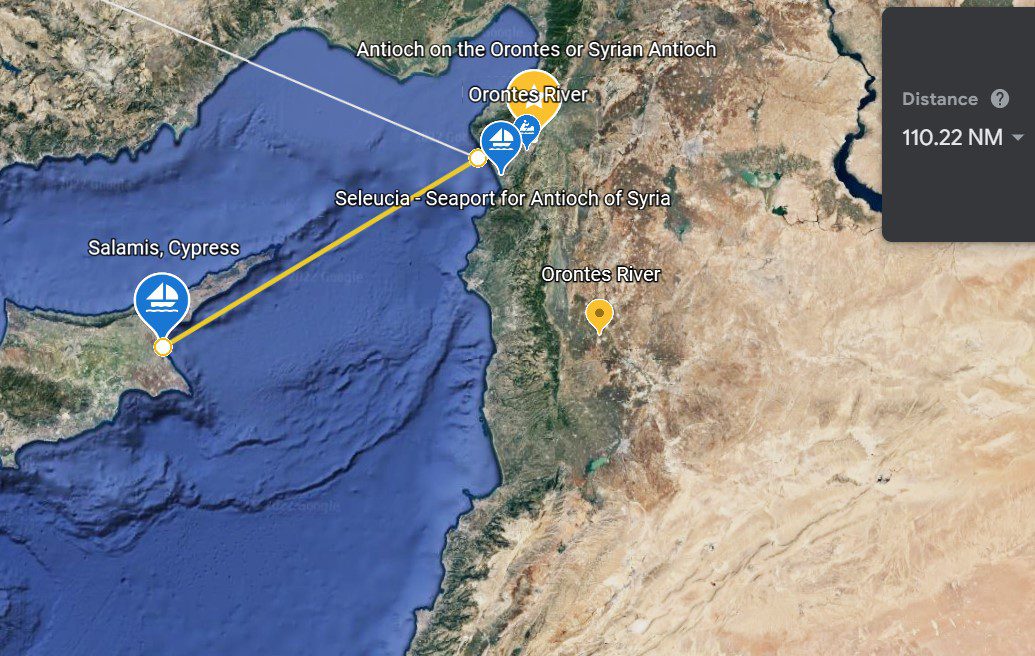Sailing from Antioch to Cypress
Acts of the Apostles 13:
4 So, being sent out by the Holy Spirit, they went down to Seleucia and from there they sailed to Cyprus.

Sailing Journeys in the Roman Empire
I don’t know about you, but I didn’t really know very much about sailing around in the Mediterranean in the first century A.D. And when I read later in Acts about wintering in some ort or about ship wrecks I had no idea what that was all about.
So here is a little I’ve learned about Paul’s journeys by ship in the first century Mediterranean Sea.
How did the ancient Romans travel?
[Like Paul and Barnabas]
- There were no passenger ships per say in first century Rome. No luxury cruise lines or anything similar.
- People willing to travel by ship had to board a merchant ship.
- They would first have to find a ship, it could be almost any kind of ship and then they would have to get the captain’s approval. The price would also be negotiated with the captain.
- Most of the times passengers would bring their own food supplies, covers, mattresses, even a tent and sleep on deck!
- Sometimes there would be hundreds of people on the deck.
- There were no restaurants or any of the luxuries of today’s ships but passengers could use the ship’s facilities to cook their meals. People would often play games, gamble, read or just drink wine.
OR perhaps a fellow passenger might ask two men like Paul and Barnabas,
“What brings you to Cypress?”
VITA ROMAE
.. Romans were not traditionally seafaring people. They were mostly land-based people who learned to build military and merchant ships from the people that they conquered. Sailing the seas was often considered un-Roman.
Romans had very few warships [BUT]
Rome managed to defeat the world’s most powerful navy to become the dominant naval power in the Mediterranean or as the Romans called it Mare Nostrum (“our sea”).
Sailing the Roman Sea
Another function of Roman military ships was to patrol the Mediterranean sea and to sometimes escort merchant ships.
- Most ships had a cargo capacity of 100 to 150 tons
- The largest ships, with a capacity of 600 tons, were 150 ft (46m) long.
- Merchant ships mainly used mainly wind power. They had from one to three masts with large square sails and a small triangular sail called the supparum at the bow.
- They also had oarsmen (usually slaves). [Roman military ships used free Roman soldiers on the oars.]
The time of travel along the many shipping lanes could vary widely. Roman ships would usually ply the waters of the Mediterranean at average speeds of 4 or 5 knots.
VITAE ROME
Salamis, Cypress

IF we do the math, allowing for the additional time in Seleucia while the cargo is loaded on their ship.. waiting in the boarding line where the captain’s representative makes certain all passengers have paid their fare.. boarding time… casting off WHEN the tide and winds seem right…
once weighing anchor, navigating the ship with new weight in the hold carefully out of the harbor…
AT 4-5 knots per hour (eventually) & depending on prevailing winds..
for perhaps 20-25 hours.. at least overnight (for this short voyage_) and timing of the tides and navigating Salamis…
[Don't you just love all that waiting before departure and docking even on a short journey?]
IF you would like to catch up to the LATEST post from our SERIES from ACTS of the Apostles CLICK HERE
So Joseph, you say you were born here?
See Acts 4:36
A Levite.
And you brought Saul here from Tarsus? (I’ve been there.)
What’s this ‘Good News’ you are bringing here?
One additional passenger
DO YOU RECALL:
Five years earlier in Jerusalem [~AD 42}: Peter amazingly appears at the gate of John Mark’s home after being freed from Herod’s prison by an angel.
AFTER Herod Agrippa died [A.D. 44]:
Barnabas and Saul returned to Jerusalem, fulfilling their ministry, taking along with them John, who was also called Mark. – Acts of the Apostles 12:25
NOW, nearly three years later [~A.D.47]:

FIRST PORT of the FIRST Missionary Journey – Salamis
- It possessed a good harbor and was the most populous and flourishing town of Cyprus
- in the Hellenic and Roman periods, carrying on a vigorous trade with the ports of Cilicia and Syria.
- Its population was mixed, consisting of Greek and Phoenician elements.
- The former, however, gave its tone and color to the city, and the chief cult and temple were those of Salaminian Zeus.
- There they preached the gospel in the “synagogues of the Jews” (Acts 13:5);
- the phrase is worth noting as pointing to the existence of several synagogues and thus of a large Jewish community in Salamis.
- Of work among the Gentiles we hear nothing,
- nor is any indication given either of the duration of the apostles’ visit or of the success of their mission;
- but it would seem that after a short stay they proceeded “through the whole island”
- Source: BibleHub.org
And when they reached Salamis, they began to proclaim the word of God in the synagogues of the Jews, and they also had John as their helper.
Acts of the Apostles Paul & Barnabas 13:5 on Cypress
WE see here just a brief first stop of Apostles sent out by the Holy Spirit with the Gospel, which Paul and Joseph of Cypress proclaim in the synagogue of Salamis to fellow Jews who have not yet heard the Good News of Jesus, the Christ promised by the Lord God.
With them, a servant helper, John Mark, who observingly will record his first Gospel published about ten years later [in the A.D. 50’s].
ACTS of the Apostles 13 on Cypress TO BE CONTINUED...

Talk of JESUS . com
Comment on Scripture – Share the Gospel

Leave a Reply